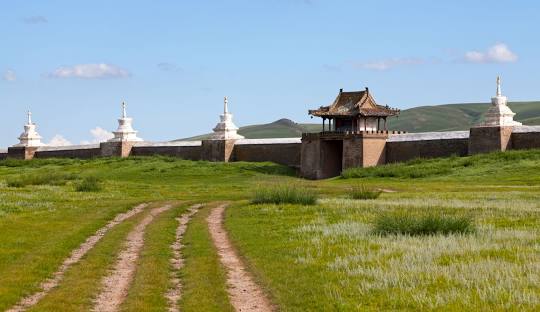Karakorum, Mongolia
✧ Karakorum, Mongolia: The Ancient Heart of the Mongol Empire ✧
➤ ✧ Introduction: A Journey Through Mongolia’s Historical Legacy
Karakorum (also spelled Kharkhorin) was once the capital of the Mongol Empire during the reign of Kublai Khan. Situated in the Orkhon Valley, this historic town is an essential destination for anyone interested in Mongolia's rich past. Karakorum is surrounded by dramatic landscapes, including the Orkhon River, lush green steppes, and towering mountains, making it a blend of history and natural beauty. Although the original city was destroyed, remnants of the Mongol Empire’s grandeur still stand in the form of ruins, ancient monasteries, and historical sites.
➤ ✧ How to Reach Karakorum
-
By Car: Karakorum is about 360 km west of Ulaanbaatar, and it takes around 7-8 hours by car. The journey takes you through Mongolia’s beautiful countryside, offering scenic views of the steppe and mountainous terrain.
-
By Bus: Public buses are available from Ulaanbaatar to Karakorum, though the trip is less flexible than traveling by private vehicle.
-
By Camel: For those interested in an authentic and adventurous experience, camel treks are available in the surrounding areas, particularly near the desert.
➤ ✧ Must-See Attractions in Karakorum
-
Erdene Zuu Monastery: This Buddhist monastery, built in 1585, is one of the oldest and most significant in Mongolia. The monastery complex is a blend of Mongolian and Tibetan Buddhist architectural styles, and it is home to many sacred relics. Erdene Zuu is surrounded by a massive wall, with 108 stupas that add to its beauty.
-
Karakorum Ruins: Although the original capital of the Mongol Empire was largely destroyed by Chinese invasions, you can still find ruins of the ancient city. Explore the remnants of the palaces, temples, and fortifications that once stood here.
-
Karakorum Museum: The Karakorum Museum offers an excellent introduction to the historical significance of the city. The museum showcases artifacts from the time of the Mongol Empire, including items related to Genghis Khan and his successors.
-
Khuvsgul Lake: While not directly within Karakorum, nearby Khuvsgul Lake offers a picturesque escape with its stunning blue waters, mountains, and wildlife.
-
The Orkhon Valley: The Orkhon Valley, a UNESCO World Heritage site, is home to several historical and natural attractions, such as the Orkhon Waterfall and ancient Turkic monuments. The valley is considered the cradle of Mongolian civilization.
➤ ✧ Adventure and Activities in Karakorum
-
Horseback Riding: Horseback riding is a great way to explore the steppe and surrounding areas of Karakorum. Riders can trek to the nearby Orkhon Valley or even visit local nomadic families to get a taste of Mongolia’s traditional way of life.
-
Trekking and Hiking: The rugged landscapes around Karakorum offer opportunities for hiking and trekking, especially near the Orkhon River and mountainous regions. Hiking around Karakorum ruins or Erdene Zuu Monastery can be especially rewarding for history and nature lovers.
-
Cultural Tours: Experience Mongolia’s ancient traditions through cultural tours, which include learning about Mongolian archery, horse racing, and throat singing. Visitors can also engage with local nomadic families to learn more about their way of life.
➤ ✧ The Nomadic Life Around Karakorum
The nomadic culture is still alive and thriving around Karakorum. Visitors can immerse themselves in this ancient lifestyle by staying with Mongolian nomads, where they can sleep in a ger, participate in everyday tasks, and enjoy traditional Mongolian meals, including mutton, milk tea, and dairy products. The proximity to Erdene Zuu Monastery also provides opportunities for spiritual experiences and insight into Tibetan Buddhism.
➤ ✧ Best Time to Visit Karakorum
-
Summer (June to August): This is the best time to visit Karakorum, as the weather is warm and conducive to outdoor activities. Temperatures range from 15°C to 25°C (59°F to 77°F), and the lush steppes are at their greenest.
-
Autumn (September to October): Fall brings cooler weather, with temperatures dropping to 10°C to 20°C (50°F to 68°F). The landscape transforms with vibrant autumn colors, making it a great time for photography.
-
Winter (November to March): The winter season in Karakorum is cold and harsh, with temperatures plunging below -20°C (-4°F). Snowfall is common, and while it’s a quieter season for tourists, it offers a unique experience for those who enjoy winter activities.
➤ ✧ Where to Stay in Karakorum
-
Luxury: While Karakorum doesn’t have many luxury hotels, some guesthouses and eco-lodges provide comfortable accommodations. There are a few desert camps that offer upscale amenities near the Orkhon Valley.
-
Mid-Range: Guesthouses and ger camps in and around Karakorum offer a more traditional Mongolian experience with basic comforts.
-
Budget: For those on a budget, camping in the wild or staying with nomadic families offers an affordable option and an authentic Mongolian experience.
➤ ✧ Practical Tips for Visiting Karakorum
✔ Pack Warm Clothing: Even in the summer months, temperatures can drop significantly in the evenings. Bring layers and a warm jacket.
✔ Bring Cash: Mongolian Tugrik (MNT) is the local currency, and it’s wise to carry cash, as ATMs can be sparse in remote areas.
✔ Respect Local Traditions: Mongolia is steeped in Buddhist and shamanistic traditions. Be respectful of local customs and sacred sites, especially when visiting monasteries.
➤ ✧ Final Thought: A Step Back in Time
Karakorum offers a unique opportunity to step back in time and explore the history of one of the world’s greatest empires. Surrounded by breathtaking landscapes and steeped in ancient culture, Karakorum is a must-visit destination for history buffs, adventure seekers, and those interested in Mongolian traditions.


